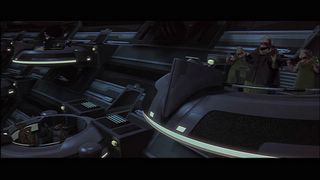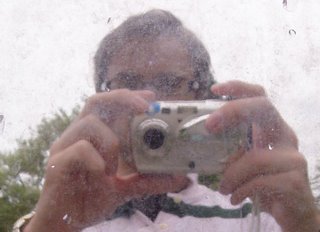"NOOOOOOOOOOOO!!!!"
(Note: Mild spoilers for Revenge of the Sith ahead)
Eco's Intertextual Collage and Revenge of the Sith
The common consensus seems to be that Revenge of the Sith is better than the other prequel movies. This doesn't mean that the film hasn't come under attack from people. It's inevitable that the people who have been claiming Lucas doesn't understand filmmaking would cry foul once again. But the more I think about the film, and upon susequent viewings (I've seen it three times now), the more impressive the Star Wars Saga in its entirity seems to me.
One scene that has been the subject of much of the outcry is the scene in which Darth Vader, newly reborn in his dark armour, queries the Emperor about the fate of Padmé. The Emperor replies that Padmé was killed by Vader in his rage (with a sick, satisfied smirk upon his evil face), and Vader bellows with a Frankenstein-esque "NOOOOOOOOOO!" The scene is somewhat cliché. The posture and tone reminds me of a Universal horror film from the 30s. Some people at our screening laughed. I had a big fat grin upon my face. Is this evidence that Lucas has lost all his skills as a director? Did he botch what was supposed to be one of the emotional climaxes of the film with cliché?
I would argue no. The film still carries emotional resonance, but perhaps differently than many viewers would expect. To understand what Lucas accomplishes in the films, I recall an essay by Umberto Eco, entitled "Casablanca: Cult movies and intertextual collage."
What are the requirements for transforming a book or a movie into a cult object? The work must be loved, obviously, but this is not enough. It must provide a completely furnished world so that its fans can quote characters and episodes as if they were aspects of the fan's private sectarian world, a world about which one can make up quizzes and play trivia games so that adepts of the sect recognize through each other a shared expertise. Naturally all these elements must have some archetypical appeal. (394)This description most definitely applies to Star Wars. This is the single greatest accomplishment of the films. He creates a self-contained world, not only with the amazing imagery and such, but also in the style of filmmaking that he has made, which many see as flaws. Eco goes on to say:
I think that in order to transform a work into a cult object one must be able to break, dislocate, unhinge it so that one can remember only parts of it, irrespective of their original relationship with the whole. In the case of a book one can unhinge it, so to speak, physically, reducing it to a series of excerpts. A movie, on the contrary, must be already ramshackle, rickety, unhinged in itself. A perfect movie, since it cannot be reread every time we want, from the point we choose [Note: Eco is writing before DVD, and I can see that DVD is changing this reality and making film more like books as I've noted before]...It should display not one central idea but many. It should not reveal a coherrent philosophy of composition. It must live on, and because of, its glorious ricketiness.Star Wars, as the child of Flash Gordon, Akira Kurosawa and Arthurian legends, is the penultimate example of this intertextual cinema made up of parts and sometimes it may seem that they don't fit together in a coherrant manner. This is the nature of the beast, but also what gives it its power. To go back to our example of Vader's Frankenstein-esque cry at the end of Sith, this is an example of Lucas using an archetypical sequence of cinematic language to communicate the monster's grief. Everyone who is reared on this kind of cinema is able to decode what is meant by Vader's cry. The scene doesn't need to be invested with the kind of care that one would a normal drama or non-cult movie. The cliché speaks volumes that might not have been possible otherwise. As Eco says, "When all the archetypes burst out shamelessly, we plumb Homeric profundity. Two clichés make us laugh but a hundred clichés move us" (401).
However, it must have some quality...Works are created by works, texts created by texts, all together they speak to each other...A cult movie is proof that, as literature comes from literature, cinema comes from cinema. (395)
Lucas has done this in all his films, mostly unintentionally. Like Tarantino in our generation, Lucas, and Spielberg also, was raised with the language of cinema. Unlike the truly universal archetypes, there are the ones that require us to know something of the intertextual history, and bring our own history to it. In these cases, Lucas and Spielberg consciously try to create some of this "intertextualization."
[In] E.T., when the alien is brought outside in a Halloween disguise and meets the dwarf coming from The Empire Strikes Back [Obviously Eco doesn't remember Yoda's name]. You remember that E.T. starts to run and cheer him. Here nobody can enjoy the scene if he [or she] does not share, at least, the following elements of intertextual competence:Lucas engages in a playful response to the scene in E.T. in the cameo appearance of a group of E.T.-type aliens in the senate scene in The Phantom Menace.
(1) He must know where the second character comes from (Spielberg citing Lucas),
(2) and, he must know something about the links between the two directors. (402)

Three E.T.'s can be spotted in the lower left hand corner box.


1 Comments:
How do you not buy Vader's fall? It's been set up for two films now that his fear of losing someone close to him (i.e. his mother or Padmé) is going to lead him to the dark side. What other possibility is there that still allows us to feel some semblance of sympathy for him? Perhaps they rushed the transition a bit (there was lot to fit into 2hr20min), but after three viewings, I don't think that's the case. I'm just curious as to what you original though would cause Anakin to turn.
Post a Comment
<< Home